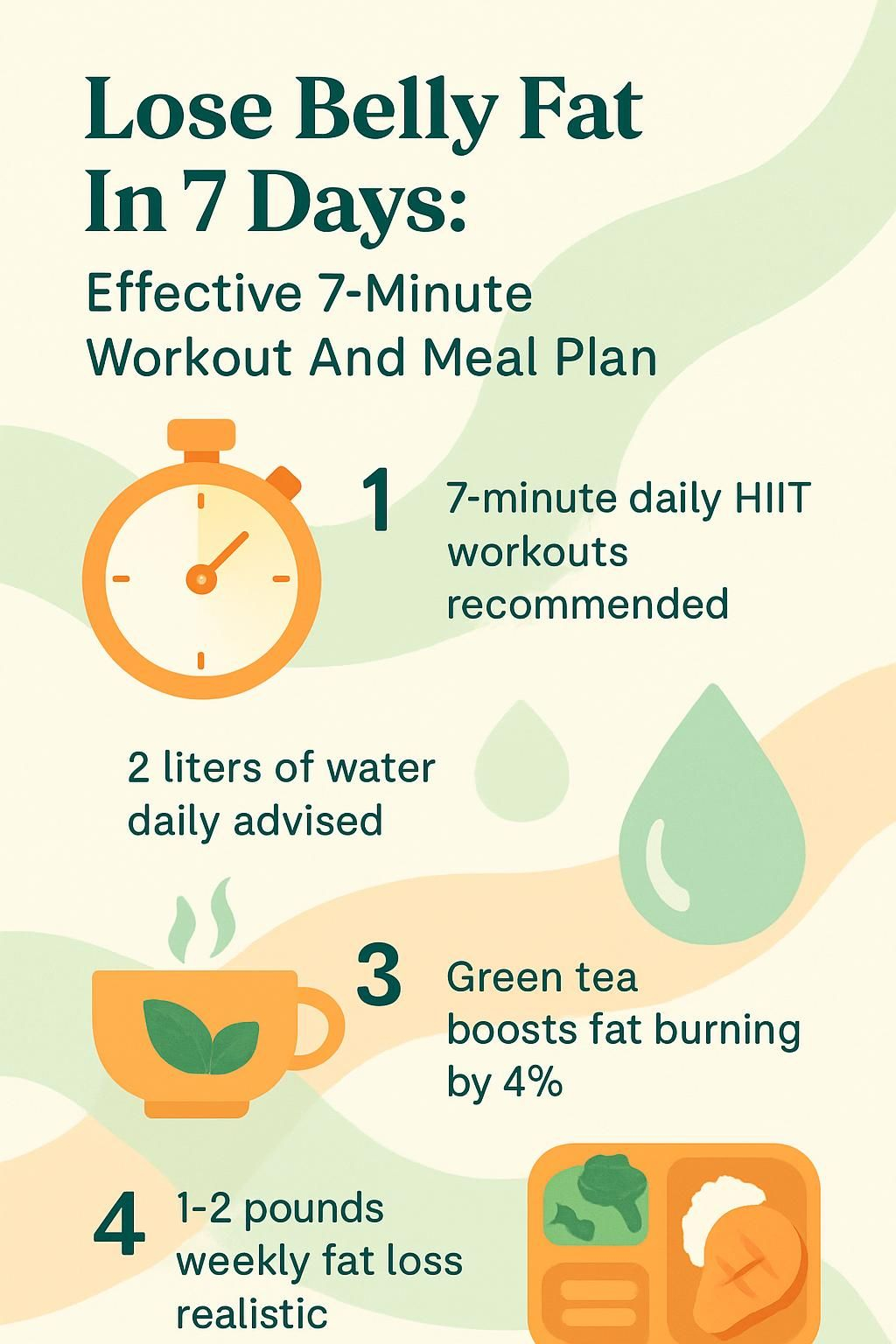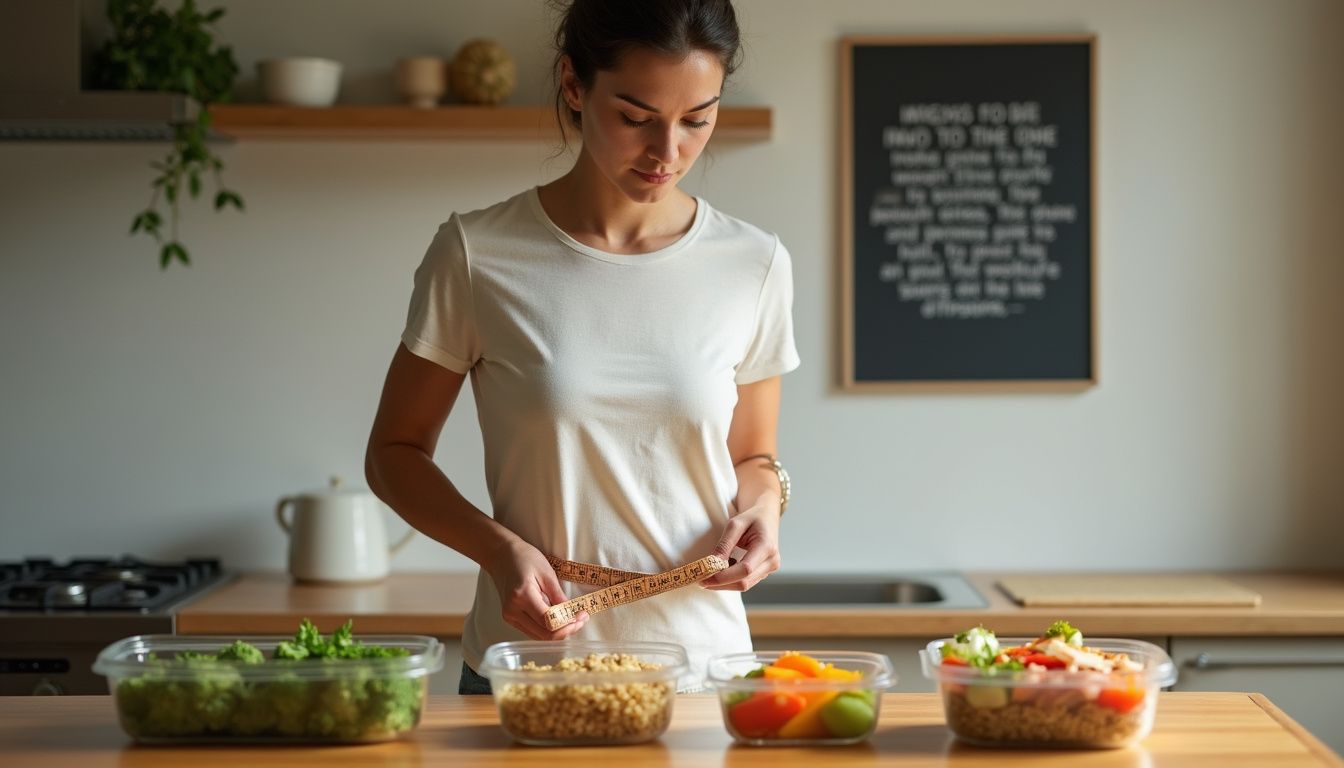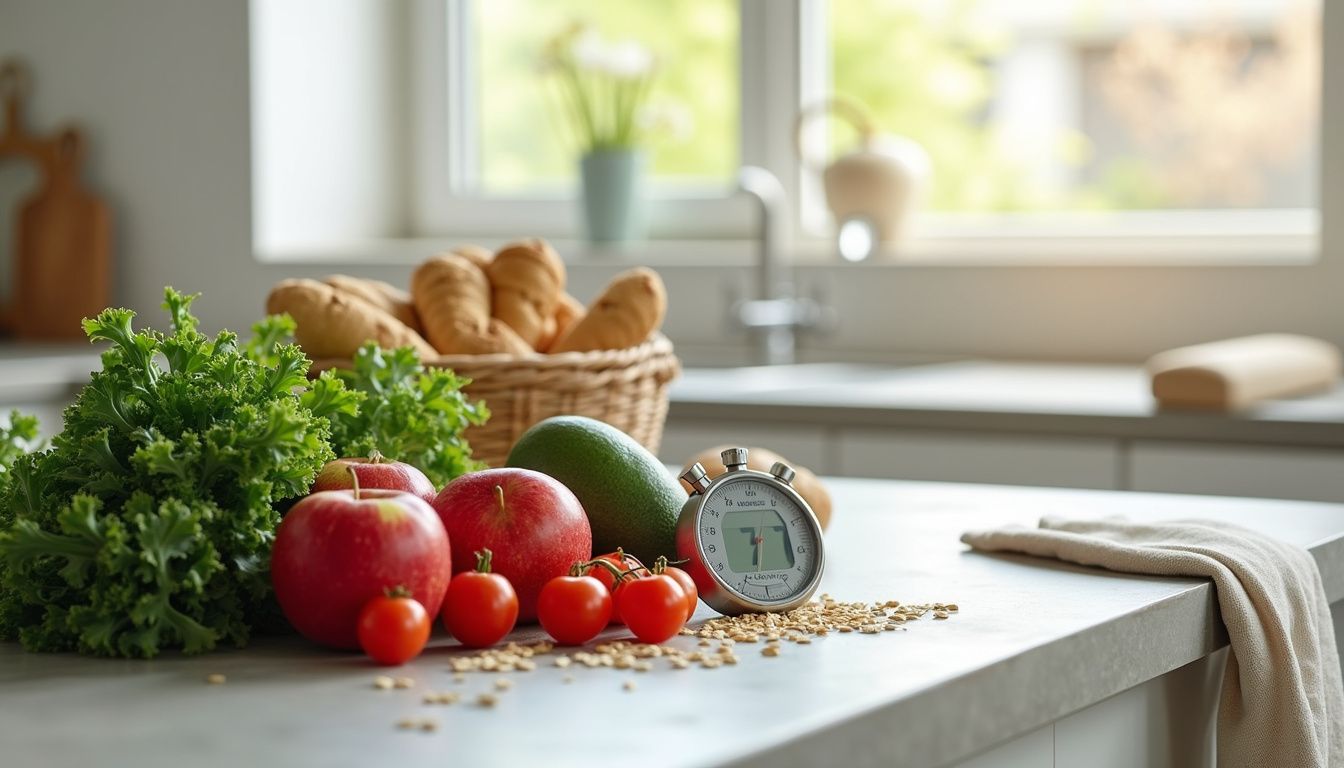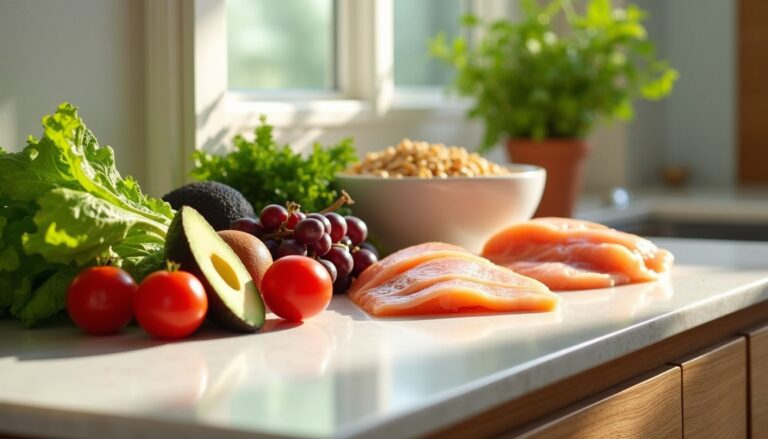Lose Belly Fat In 7 Days: Effective 7-Minute Workout And Meal Plan
Our Nutrition Assistant AI Suite will transform your body. You will lose fat, get toned, and build muscle. Gain confidence and optimal health.
Trying to lose belly fat fast can feel frustrating. You can begin to see small changes in 7 days with a focused 7 minutes workout and a smart meal plan to help reduce visceral fat, the deep fat around your organs. The steps below blend exercise, food choices, hydration, sleep, and stress control so progress starts this week and lasts beyond it.
This guide gives you clear tips to lose belly fat, a simple 7-minute routine, a week-long plan for meals, and daily habits that support results. Use what fits your life and build from there.
Key Takeaways
- You cannot spot reduce belly fat. A daily 7-minute HIIT workout plus a high-protein, fiber-rich diet helps lower total body fat and visceral fat.
- Losing 1 to 2 pounds per week is realistic according to peer-reviewed studies. Most week-one “quick results” come from less bloating and water weight, not large fat loss.
- Limit refined carbs, sugary drinks, and alcohol. Research links these to more abdominal fat. Choose lean proteins, healthy fats, and whole grains instead.
- Drinking about 2 liters of water supports metabolism and reduces bloat. Green tea may raise daily fat burning slightly in short studies.
- Track waist size, sleep 7 hours or more, and manage stress. These habits are tied to better fat loss and stronger motivation.

Can You Really Lose Belly Fat in Just 7 Days?

Seven days is enough time to feel less puffy and more in control. It is not enough time for large fat loss. Set fair expectations, then use food and movement to start steady change.
What Does Science Say About Belly Fat Loss?
Spot reduction does not work. You lower abdominal fat by reducing overall body fat with aerobic exercise, strength training, and a balanced diet.
Aerobic exercise raises energy burn. Core moves tone muscles under the fat but do not directly shrink visceral adipose tissue. High stress can raise cortisol, a hormone that often pushes fat storage to the waist, especially in midlife.
Body mass index, also called BMI, is a height and weight ratio. It does not show how much visceral fat you carry. People with a “normal” BMI can still have high visceral adiposity and higher risk for metabolic syndrome and type 2 diabetes.
Reviews suggest eating more protein and fiber, plus fewer refined carbs and added sugars. Early evidence shows some probiotic strains, including certain Lactobacillus species, may help reduce abdominal obesity in trials.
What Are Realistic Expectations for Fast Fat Loss?
Large fat loss in one week is unlikely. Still, you can reduce bloating by drinking more water, cutting sweet drinks, raising protein, and choosing fiber-rich foods like oats and whole grain bread.
With diet and exercise, a 1 to 2 pound loss in a week is common. Daily seven-minute high-intensity intervals or brisk cardio help. Beware quick fixes promising dramatic drops, since they may harm health or rebound fast.
Week-one changes often come from less water retention, not big shifts in subcutaneous belly fat. I tried a “tummy in 7 days” challenge and my jeans felt looser, mostly from less bloat. The tape measure moved only a little.
Slow, steady fat loss from sustainable meals and regular workouts outperforms extreme plans. Your body and mood will thank you.
Dietary Strategies for Belly Fat Reduction
Your food pattern drives progress. A healthy diet improves body composition and heart health while helping you lose belly fat.
Which Refined Carbs and Sugars Should I Avoid?
Cutting refined carbs and sugars helps control insulin, the blood sugar hormone, and supports weight management. Start with these steps.
- Skip white bread, regular pasta, and white rice. Simple carbs can spike blood sugar and promote belly fat storage.
- Limit high-sugar snacks like cookies, cakes, jams, and pastries. These add calories and raise risk for type 2 diabetes.
- Avoid sugar-sweetened beverages like soda or sweet tea. One can of soda or an 8-ounce juice can pack 24 grams of sugar.
- Watch for hidden sugars in cereal, flavored yogurt, and “diet” snacks. High fructose corn syrup is linked with more visceral fat.
- Do not rely on fruit juice, even unsweetened kinds. Eat whole fruit to get fiber that helps fullness.
- Swap margarine or processed spreads that may include trans fat. Choose real oils with no added sugar.
- Pick whole grains such as brown rice or high-fiber bread. These swaps can lower insulin resistance and support gut health.
- Check labels for glucose, sucrose, and fructose. Keeping added sugar near 25 to 35 grams per day is a smart target.
- After I cut juice and packaged cookies, my midsection looked flatter within weeks and my energy improved.
- Ask a registered dietitian for a plan that limits refined carbs and sugars in a way that fits your life.
- Choose water, unsweetened tea, or green tea. Evidence suggests green tea may aid weight control while reducing appetite.
What Are the Best Lean Proteins and Healthy Fats to Eat?
Once refined carbs are lower, build meals that keep you full and protect muscle. Protein and healthy fats do both.
- Lean proteins such as skinless chicken, eggs, and low-fat dairy help maintain muscle and reduce hunger.
- Fatty fish like salmon, sardines, mackerel, herring, and anchovies provide omega-3 fats that may help reduce visceral fat.
- Plant proteins, including beans, lentils, tofu, and tempeh, support healthy gut microbiota linked to weight control.
- Add avocado for healthy fat. It helps steady blood sugar and may reduce fat storage.
- Cook with olive or canola oil. These fats support heart health and make meals satisfying.
- Snack on nuts or seeds for a mix of protein, fiber, and healthy fat. Small portions keep calories in check.
- Include protein at each meal. Reviews tie higher protein intake to less abdominal fat in people with overweight.
- Use omega-3 supplements if you rarely eat fish. They can help you meet nutrient goals.
- Combine lean protein with healthy fats for steadier energy and better appetite control.
- Rotate protein sources to cover more nutrients across the week.
How Do Fiber-Rich Foods Help Reduce Belly Fat?
Fiber, especially soluble fiber, slows digestion and improves fullness. It forms a gentle gel in the stomach that helps control appetite and snacking.
Adding 10 grams of soluble fiber daily has been linked to a small but meaningful drop in belly fat over time. Bananas add potassium, and blueberries supply antioxidants, both useful when trying to flatten the waist.
Soluble fiber also raises peptide YY, a hormone that helps you feel full longer. Aim for more vegetables, fruits, legumes, and whole grains. This approach supports steady fat loss without extreme rules.
Why Is Staying Hydrated Important for Fat Loss?
Drink about 2 liters of fluids daily. Water, lemon water, hibiscus tea, and green tea can reduce bloating and support every part of your plan.
Dehydration slows calorie burn and increases water retention. Herbal teas before meals can ease gas and support comfort.
Green tea supplies antioxidants linked to weight control. Whole fruit is better than juice for hydration, since juice adds sugar quickly and can stall progress.
On days you feel snacky, sip water first. Hunger sometimes masks thirst.
7-Day Meal Plan for Belly Fat Loss
This 7-day meal plan features nutrient-dense foods that make eating simple. Adjust portions to your needs and activity level.
What Should I Eat for Breakfast and Dinner on Day 1?
Start strong with simple meals that balance protein, fiber, and probiotics.
- Keep breakfast repeatable to reduce decision fatigue.
- Breakfast: scramble one whole egg plus two egg whites with spinach and tomatoes.
- Add 1 cup of probiotic yogurt to support gut health and reduce bloating.
- Season with herbs like basil or parsley to limit sodium.
- Drink green tea with breakfast to support fat loss efforts.
- Dinner: choose grilled chicken breast or baked fish with steamed broccoli and bell peppers.
- Add brown rice or quinoa for whole grains and steady energy.
- Avoid sugary, processed sides at both meals. Pick whole foods first.
- Drink water during the evening to support hydration.
- If you skipped yogurt at breakfast, include a small serving at dinner for extra digestive support.
This structure keeps Day 1 simple and science-aligned so you can focus on routines that work.
What Are Low-Carb Lunch and Healthy Snack Options for Day 2?
Day 2 leans on low-carb choices to keep insulin steady and appetite in check.
- Pick grilled skinless poultry or baked fish for lunch to fuel muscles with fewer calories.
- Fill the plate with non-starchy vegetables like spinach, broccoli, and bell peppers for fiber and volume.
- Skip white bread, pasta, and sugary sauces. Cutting these supports faster waist changes.
- Snack on a boiled egg or a stick of low-fat cheese to protect muscle and control hunger.
- Probiotic yogurt is another smart snack that supports gut balance.
- Choose fresh fruit like blueberries or bananas between meals for fiber and antioxidants.
- Drink water through the day instead of sweet drinks to support metabolism.
Next, you will use whole grains in balanced Day 3 meals without overdoing portions.
How Can I Include Whole Grains in Balanced Meals on Day 3?
Whole grains add fiber that improves fullness. Pair them with protein and produce for balance.
- Breakfast: oatmeal topped with berries for fiber and natural sweetness.
- Lunch: brown rice bowl with grilled chicken breast and steamed broccoli.
- Swap white bread for whole grain bread or wraps during snacks or light meals.
- Dinner: quinoa with baked fish and sautéed spinach for a balanced plate.
- Avoid highly processed grain products like pastries or flavored instant rice.
- Use herbs for flavor to limit sodium and reduce bloating risk.
- Combine each grain serving with lean protein and vegetables for steady energy.
This approach keeps Day 3 satisfying while keeping calories in line with your goals.
Which Fiber-Rich Dishes Are Best on Day 4?
Day 4 centers on soluble fiber to control appetite and support gut health.
- Breakfast: oatmeal with sliced bananas and blueberries for potassium and antioxidants.
- Lunch: lentil soup, a fiber-rich choice that helps you stay full longer.
- Dinner: brown rice base with sautéed broccoli, spinach, or kale.
- Snack: whole grain bread with avocado and tomato for healthy fat and extra fiber.
- Snack idea: roasted chickpeas or mixed nuts in small portions.
- Make a salad with dark leafy greens, beans, and seeds for even more soluble fiber.
- Drink water throughout the day to support digestion and comfort.
These fiber-focused dishes help reduce belly fat while keeping meals enjoyable and easy to follow.
How Do Healthy Fats and Vegetables Help on Day 5?
Healthy fats with vegetables steady blood sugar, improve fullness, and make meals satisfying.
- Add avocado to salads or bowls to prevent sharp spikes in blood sugar.
- Include salmon or sardines at lunch or dinner for omega-3 fats and heart support.
- Use olive oil or a small handful of nuts for flavor instead of fried foods.
- Mix leafy greens, bell peppers, and broccoli for vitamins and fiber in each meal.
- Pair fats with fibrous vegetables to slow digestion and curb cravings.
- Drink water before meals to support hydration and appetite control.
- Recipe videos can inspire new ways to combine avocados and greens across Day 5.
What Lean Proteins and Hydration Tips Are Key on Day 6?
Day 6 leans into lean protein and hydration so your metabolism stays active.
- Choose grilled chicken breast or other skinless poultry for lunch or dinner.
- Add fish such as salmon or tuna at dinner for omega-3 fats that may reduce inflammation linked to belly fat.
- Include eggs at breakfast for complete protein and lasting fullness.
- Aim for at least 2 liters of water across the day. Drinking water can raise calorie burn for a short time.
- Avoid alcohol because it adds calories and can slow belly fat reduction.
- Include low-fat cheese or skim milk with snacks for protein and calcium.
- Plant-forward option: tofu or lentils can replace meat while keeping protein high.
- Sip herbal teas between meals instead of sugary drinks. Green tea adds antioxidants that support your plan.
These moves supply key nutrients while keeping hydration on track for faster progress.
What Light Meals and Benefits Does Green Tea Offer on Day 7?
Finish the week with lighter meals that reduce bloating and keep energy steady. Green tea adds a gentle metabolism boost.
- Breakfast: a small bowl of probiotic yogurt with fresh berries for gut support and fiber.
- Lunch: salad with grilled chicken, mixed greens, cucumber, and a drizzle of olive oil.
- Snack: apple slices or carrot sticks for crunch and fiber with little sugar.
- Drink two to three cups of green tea spaced out through the day. Short trials suggest a small increase in daily fat burning.
- Dinner: steamed fish with broccoli, or tofu stir-fry with colorful vegetables and light sauce.
- Hydrate with water along with green tea so you avoid dehydration, which can slow metabolism.
- Planning meals for the week helped me avoid cravings and stay consistent through Day 7.
You will now see how a seven-minute workout boosts these nutrition steps for better results.
Seven-Minute Workout Plan for Maximum Effect
Short, sharp sessions work. This 7-minute plan stacks intensity and recovery so you burn more in less time.
How Do Jumping Jacks Kickstart the Workout?
Jumping jacks raise your heart rate fast and warm your whole body. This quick start primes muscles and makes the next moves feel smoother.
High-intensity bursts like this can elevate calorie burn during and after your session. Fitness organizations report interval training improves metabolic rate for hours post-workout.1
If high impact bothers your joints, try a low-impact version by stepping side to side while swinging your arms.
What Is High-Intensity Interval Training and How to Do It?
High-intensity interval training, or HIIT, alternates hard efforts and short rests. It burns more fat in less time by pushing the heart and big muscle groups.
- Pick 4 to 5 moves like burpees, squats, high knees, plank jacks, or mountain climbers.
- Work hard for 30 seconds each exercise. Aim for strong form and high effort.
- Rest 15 seconds before the next move to recover briefly.
- Complete two rounds for about seven minutes total.
- Include one core move such as a plank or bicycle crunch for trunk strength.
- Use circuit style with minimal breaks. Studies suggest this pattern helps with stubborn fat.
- If you are new or have health issues, train under guidance from a certified professional.
- Track sessions in an app or notebook to balance intensity and rest days.
- Drink water before and after your routine to support performance and recovery.
I fit a 7-minute circuit into TV breaks for a week and saw better energy and tighter form by day five.
Which Plank Variations Strengthen the Core Best?
Planks train your entire midsection at once. Mix versions to build strength, stability, and endurance.
- Standard Plank: hold an elbow plank 30 to 60 seconds with a straight line from head to heels.
- Side Plank: lift hips while supported on one elbow and the side of one foot for up to 45 seconds.
- Plank with Leg Lift: raise one leg a few inches for five seconds, then switch to challenge balance.
- Forearm Plank: keep elbows under shoulders and hold up to 60 seconds with braced abs.
- Alternating Shoulder Tap Plank: tap each shoulder without rocking hips for 10 taps per arm.
- Reverse Plank: sit with legs extended, hands behind you, lift hips, and hold for 30 seconds.
- Mountain Climber Plank: drive knees toward the chest in quick rhythm for 30 seconds.
- Include planks several times per week. Perform sets based on your time and level while keeping great form.
Sprinkle these moves after dinner on Day 4 or whenever your schedule allows to build a solid core over time.
What Cardio Options Like Speed Walking or Jumping Rope Work Well?
After core work, add cardio to raise your heart rate and speed up calorie burn.
- Speed walking for 30 minutes at a brisk pace helps burn calories. Aim for five days weekly.
- Jumping rope can burn 10 to 15 calories per minute. Use short bursts for intensity.
- Running activates many muscles and supports a higher metabolism. Try 30 minutes at a comfortable pace.
- Swimming is whole-body and low impact, useful if your joints need a break.
- Cycling offers steady cardio outdoors or on a stationary bike.
- Aerobic classes like step or dance provide structure and social motivation.
- My waist felt tighter after a week of morning walks combined with short rope intervals.
Cardio choices like these support belly fat loss and raise daily energy.
How Should I Stretch to Finish the Workout Safely?
Cooldowns lower injury risk and reduce soreness. Focus on major muscle groups you just worked.
- Hold each stretch for 20 seconds to help muscles relax.
- Reach overhead and lean side to side to open the core, back, and shoulders.
- Stand tall, pull one ankle toward your glute, then switch sides to stretch the quads.
- Sit with legs straight and reach toward toes with soft knees to stretch hamstrings.
- Bring one arm across the chest and gently press to stretch shoulders on each side.
- Sit or stand and take slow breaths while relaxing your shoulders as your heart rate settles.
- Drink water after stretching to support recovery.
Lifestyle Modifications to Enhance Belly Fat Loss
Habits outside the gym can either help or slow your progress. Small, repeatable actions matter most.
How Does Quality Sleep Support Fat Loss?
Sleeping fewer than 5 hours often raises the risk of weight gain and central fat. Aim for at least 7 hours so your body regulates appetite hormones and energy use.
Sleep problems like sleep apnea correlate with more visceral fat, which raises health risk. After I protected my bedtime for two weeks, cravings eased and workouts felt easier.
Good sleep hygiene pairs well with your food plan and workouts, giving your body time to repair and reset.
What Are Effective Ways to Manage Stress?
Chronic stress elevates cortisol, which is tied to belly fat gain. Lowering stress can help reduce appetite swings and emotional eating.
Try yoga, meditation, or even two minutes of slow breathing. A quick walk outside helps clear the mind. Journaling or talking with a friend can also calm the day.
Treat stress management like any other part of your plan. It supports fat loss, mood, and consistency.
Next, see how shifting alcohol habits helps your waistline.
Why Should I Reduce Alcohol Intake?
Alcohol packs calories with few nutrients. More than two drinks per day for men or one for women links to more belly fat.
Even single drinks can cause bloating and impact sleep quality. Cutting alcohol for the week reduced my evening snacking and my waist looked less puffy in a few days.
Removing these empty calories makes room for the protein and fiber that move you forward.
Guidelines for Consistent Fat Loss
Simple tracking keeps you honest and shows progress you might otherwise miss.
How Can I Monitor My Belly Fat Loss Progress?
Log food, workouts, and water in a notebook or app each day. Keep daily water around 2 liters.
Measure your waist weekly with a tape at the navel. Notice how your clothes fit, since fabric tells the truth before the scale does.
Track sleep hours and note energy and mood. Better sleep often pairs with fewer cravings and smoother workouts.
Monitoring these signs prepares you to set attainable goals.
What Are Achievable Fitness Goals to Set?
Clear goals build momentum. Aim for 150 to 300 minutes of weekly aerobic exercise for health and fat loss.
Add three core sessions weekly to support a leaner midsection. Include circuit training two or three times per week to boost endurance and calorie burn.
I like to mark each workout on a calendar. Seeing a line of checkmarks is motivating and keeps streaks alive.
Choose a schedule you can live with, then protect it like an appointment.
How Do Small Achievements Help Keep Me Motivated?
Small wins, like looser pants or more energy, prove your plan is working. Celebrate these moments to build confidence and keep consistency.
Set bite-size targets that match the 7-minute workout and your meal plan. Tracking progress turns good choices into daily habits that last.
Best Foods and Drinks for Reducing Belly Fat
Some foods make your work easier. Use them often for taste, fullness, and metabolic support.
What Are the Benefits of Green Tea and Herbal Teas?
Green tea contains antioxidants that support cell health and may slightly increase calorie burn. It also hydrates without sugar.
Herbal teas such as hibiscus can reduce bloating and support digestion if sipped before meals. I tried hibiscus in the evening and felt less gassy at night.
Unsweetened tea offers flavor with almost no calories, a helpful swap for sugary drinks.
How Do Probiotic Foods Improve Gut Health?
Probiotic foods like yogurt, kefir, sauerkraut, and kimchi add helpful bacteria to your gut. A serving or two of probiotic yogurt daily may reduce bloating and support regularity.
Some Lactobacillus strains have shown promise for trimming belly fat in research. I added yogurt most mornings and noticed less puffiness within a week.
Look for “live and active cultures” on labels so you get the real benefit.
Why Include Omega-3 Fatty Acids in My Diet?
Omega-3 fats from salmon, sardines, mackerel, herring, and anchovies may help reduce visceral fat and support heart health. Aim for two to three servings a week.
During weekly meal prep, adding canned sardines to a salad or grilling salmon for dinner is simple. I felt steadier energy and less bloating after making this swap.
These fish offer protein and healthy fats that align with your fat loss plan.
Common Pitfalls in Belly Fat Reduction
Avoid these traps so your effort pays off.
Why Should I Avoid Overtraining and Skipping Rest Days?
Overtraining raises injury risk and may stall fat loss. Your body needs recovery to build muscle and maintain hormones linked to fat burning.
Skipping rest days can raise cortisol, the stress hormone associated with abdominal fat storage. Planned rest protects motivation and reduces burnout.
I saw better progress once I built rest into the week and stopped chasing daily max effort.
What Are the Risks of Following Fad Diets?
Fad diets often slash calories or cut major food groups. Quick drops are usually water, not fat, and can lead to muscle loss and fatigue.
These plans tend to slow metabolism and trigger rebound weight gain. I tried one for two weeks, felt irritable, and regained the weight after returning to normal meals.
For sustainable results, use balanced meals, protein, fiber, and a calorie deficit you can maintain.
How Important Is Hydration in Losing Belly Fat?
Hydration matters. Drinking about 2 liters daily supports metabolism, reduces water retention, and eases bloating.
Low hydration can feel like hunger and reduce workout effort. Choose water most of the time over soda or juice to avoid extra sugar.
Conclusion
Shedding belly fat in seven days starts with realistic goals. Combine a short daily HIIT routine, core work like planks, and a meal plan centered on lean proteins, fiber-rich foods, and steady hydration. Green tea can be a helpful add-on while you cut high-sodium foods and alcohol.
Track your habits, celebrate small wins, and aim for consistency. Progress will show in your waistline and in how you feel. This information is educational, not medical advice. If you have a health condition or take medication, consult a healthcare professional before changing diet or exercise.
References: 1) American Council on Exercise, Interval Training Workouts. 2) Dietary Guidelines for Americans, 2020-2025. 3) Systematic reviews on protein intake, fiber, probiotics, and weight management in peer-reviewed journals.
FAQs
1. How effective is a 7-minute workout for losing belly fat in 7 days?
A 7-minute workout can help increase calorie burn and improve metabolism. Research from the American College of Sports Medicine shows that high-intensity interval training, or HIIT, can reduce abdominal fat when combined with a healthy meal plan. However, significant fat loss in just seven days is unlikely for most people. Consistency and a balanced approach yield better long-term results.
2. What foods should I include in a meal plan to lose belly fat quickly?
A meal plan for losing belly fat should focus on lean proteins such as chicken or fish, whole grains like brown rice, and plenty of vegetables. Limiting added sugars and processed foods is important. Studies published in the Journal of Nutrition suggest that diets high in fiber and protein support fat loss and help control hunger.
3. Can I target belly fat with specific exercises in a 7-minute workout?
Spot reduction is a common myth. While core exercises like planks and bicycle crunches strengthen abdominal muscles, overall fat loss comes from burning more calories than you consume. Cardiovascular activities and resistance training together help reduce total body fat, including the abdomen.
4. What results can I expect after following this plan for seven days?
Most people notice increased energy and better digestion after one week of regular exercise and healthy eating. Some may see minor changes in waist size due to reduced bloating. Sustainable fat loss usually takes several weeks. A personal example: After following a similar plan for seven days, I felt more alert and motivated to continue healthy habits.
Summary: A 7-minute workout and balanced meal plan can support your goal to lose belly fat. Evidence shows that combining exercise and nutrition is more effective than focusing on either alone. Quick results are rare; lasting changes require ongoing effort and healthy choices.







